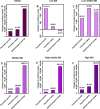Changing epidemiology of calcific aortic valve disease: 30-year trends of incidence, prevalence, and deaths across 204 countries and territories
- PMID: 33973531
- PMCID: PMC8148466
- DOI: 10.18632/aging.202942
Changing epidemiology of calcific aortic valve disease: 30-year trends of incidence, prevalence, and deaths across 204 countries and territories
Abstract
Calcific aortic valve disease (CAVD) is associated with increased morbidity and mortality. We aimed to elucidate the 30-year epidemiology of CAVD globally. Global CAVD incidence, prevalence, and deaths increased 3.51-, 4.43-, and 1.38-fold from 1990 to 2019, respectively, without any decreasing trends, even after age standardization. In 2019, Slovenia had the highest age-standardized rate (ASR) of CAVD incidence (62.21/100,000 persons) and prevalence (1,080.06/100,000) whereas Cyprus had the highest ASR of deaths (8.20/100,000). Population aging was an important contributor to incidence. Compared with women, more men had CAVD and men had earlier peaks in disease prevalence. High systolic blood pressure, diet high in sodium, and lead exposure were the main risk factors for deaths owing to CAVD. The estimated annual percentage change, a measure to estimate the variation of ASR, was significantly associated with the ASR and sociodemographic index (SDI) in 2019 for incidence and prevalence across all 204 countries and territories (all p<0.0001). With increased lifespan and risk factors, the overall burden of CAVD is high and remains on the rise, with differences by sex, age, and SDI level. Our findings serve to sound the alarm for organizations, institutions, and resources whose primary purpose is to improve human health.
Keywords: 30-year trends; calcific aortic valve disease; epidemiology; incidence; prevalence.
Conflict of interest statement
Figures







References
-
- Rajamannan NM, Evans FJ, Aikawa E, Grande-Allen KJ, Demer LL, Heistad DD, Simmons CA, Masters KS, Mathieu P, O’Brien KD, Schoen FJ, Towler DA, Yoganathan AP, Otto CM. Calcific aortic valve disease: not simply a degenerative process: A review and agenda for research from the National Heart and Lung and Blood Institute Aortic Stenosis Working Group. Executive summary: Calcific aortic valve disease-2011 update. Circulation. 2011; 124:1783–91. 10.1161/CIRCULATIONAHA.110.006767 - DOI - PMC - PubMed
Publication types
MeSH terms
Substances
Supplementary concepts
LinkOut - more resources
Full Text Sources
Other Literature Sources
Medical

